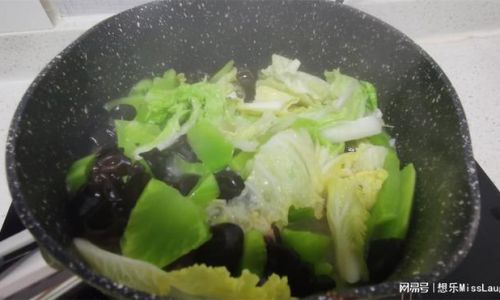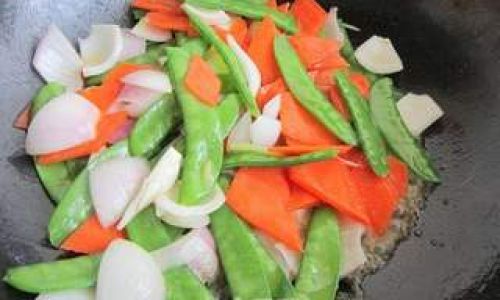Stir-fried three vegetables delight, often referred to as chao su san xian in Chinese cuisine, is a vibrant, nutrient-packed dish that celebrates the natural flavors and textures of fresh produce. This dish typically combines three key vegetables—commonly bell peppers, carrots, and mushrooms—but variations may include broccoli, zucchini, or snap peas. The beauty of this recipe lies in its simplicity, versatility, and ability to adapt to seasonal ingredients. Whether you’re a seasoned home cook or a novice in the kitchen, mastering this dish will equip you with a go-to meal that’s both visually appealing and deeply satisfying. Below, we’ll explore the step-by-step process of creating this delightful dish, along with tips for customization and elevating its flavors.
The Essence of Stir-Fried Three Vegetables Delight
Stir-frying is a cornerstone of Chinese cooking techniques, prized for its ability to retain the crispness, color, and nutrients of vegetables while infusing them with aromatic flavors. The term san xian translates to “three fresh ingredients,” highlighting the dish’s focus on seasonal, high-quality produce. Unlike heavy, saucy stir-fries, this recipe emphasizes a light, clean taste, allowing each vegetable’s unique character to shine. The dish is often served as a side or main course in vegetarian meals, paired with steamed rice or noodles.

Ingredients: Building the Foundation
To create a balanced stir-fried three vegetables delight, select vegetables that offer contrasting colors, textures, and flavors. Here’s a classic ingredient list, along with substitutions to suit availability or dietary preferences:
- Bell Peppers (1 red, 1 yellow): Adds sweetness and crunch. Substitute with cubed zucchini or thinly sliced cabbage.
- Carrots (1 medium): Provides earthy sweetness and a firm texture. Replace with daikon radish or jicama for a crisper bite.
- Shiitake Mushrooms (4–6 fresh or dried): Offers umami depth. Use oyster mushrooms or enoki mushrooms as alternatives.
- Garlic (3 cloves): Infuses the dish with aromatic pungency. Adjust quantity to taste.
- Ginger (1-inch piece): Adds a subtle, warming spice. Omit for ginger-free preferences.
- Scallions (2 stalks): Provides fresh, oniony notes. Garnish with chopped cilantro if unavailable.
- Cooking Oil (2 tbsp): Use neutral oils like peanut, vegetable, or avocado oil.
- Soy Sauce (1 tbsp): Enhances saltiness and umami. Tamari or coconut aminos work for gluten-free diets.
- Sesame Oil (1 tsp, optional): Adds nutty richness. Use sparingly to avoid overpowering the dish.
- Salt and Pepper (to taste): Balances flavors.
- Cornstarch Slurry (1 tsp cornstarch + 2 tbsp water, optional): Thickens the sauce for a glossy finish.
Preparation: The Key to Perfect Texture
Proper preparation ensures even cooking and preserves the vegetables’ vibrant hues. Follow these steps:
- Wash and Dry Vegetables: Pat all vegetables dry to prevent excess moisture from steaming instead of stir-frying.
- Uniform Cutting: Slice vegetables into similar sizes for consistent cooking.
- Bell peppers: Julienne into 2-inch strips.
- Carrots: Cut into thin matchsticks or diagonal slices.
- Mushrooms: Halve or quarter if large; leave small ones whole.
- Aromatics Prep: Mince garlic and ginger finely. Chop scallions into 1-inch segments, separating white and green parts.
- Sauce Mixing: In a small bowl, combine soy sauce, sesame oil (if using), and cornstarch slurry (if desired). Stir until smooth.
Cooking Process: Mastering the Stir-Fry
Stir-frying requires high heat and quick movements to achieve the signature wok hei (breath of the wok). Here’s how to execute it flawlessly:

- Heat the Wok: Place a wok or large skillet over high heat. Add oil and swirl to coat the surface. Wait until the oil shimmers but does not smoke.
- Sauté Aromatics: Toss in garlic, ginger, and the white parts of scallions. Stir-fry for 10–15 seconds until fragrant, avoiding burning.
- Add Vegetables by Cooking Time: Introduce vegetables in order of firmness to ensure even doneness:
- First, add carrots (hardest). Stir-fry for 2 minutes.
- Next, add bell peppers. Cook for 1–2 minutes.
- Finally, add mushrooms. Stir-fry for 1 minute.
- Season and Toss: Pour the sauce mixture over the vegetables. Toss gently to coat, ensuring the cornstarch thickens the sauce slightly.
- Finish with Freshness: Sprinkle the green scallion parts and a pinch of white pepper (optional). Remove from heat immediately to prevent overcooking.
Pro Tips for Stir-Frying Success
- High Heat is Non-Negotiable: Low heat will cause vegetables to release moisture, resulting in a soggy texture.
- Avoid Overcrowding: Cook in batches if necessary. Overcrowding the pan steams vegetables instead of searing them.
- Taste and Adjust: Season with salt or a splash of soy sauce if needed. A squeeze of lime juice can brighten the dish.
- Customize the Sauce: For a spicy kick, add chili paste or fresh chili peppers. For sweetness, incorporate a teaspoon of honey or mirin.
Health Benefits: A Nutritional Powerhouse
Stir-fried three vegetables delight is a low-calorie, high-fiber dish bursting with vitamins and antioxidants:
- Bell Peppers: Rich in vitamin C, which supports immune health and skin vitality.
- Carrots: Packed with beta-carotene, essential for eye health and skin renewal.
- Mushrooms: Provide B vitamins, selenium, and immune-boosting properties.
- Ginger and Garlic: Contain anti-inflammatory compounds and aid digestion.
This dish is also naturally gluten-free and vegan, making it suitable for diverse dietary needs.
Serving Suggestions: Beyond the Basic Bowl
- Pair with Grains: Serve over jasmine rice, quinoa, or cauliflower rice for a complete meal.
- Noodle Integration: Toss with udon noodles or soba noodles for a heartier version.
- Lettuce Wraps: Use butter lettuce leaves as cups for a refreshing, low-carb appetizer.
- Protein Boost: Add crispy tofu, tempeh, or edamame for extra protein.
Variations to Explore
- Springtime Twist: Swap carrots for asparagus and add snow peas. Garnish with fresh mint.
2 Autumn Edition: Use butternut squash, shiitake mushrooms, and kale. Drizzle with toasted sesame seeds. - Spicy Sichuan Style: Incorporate doubanjiang (fermented chili bean paste) and Sichuan peppercorns.
- Kid-Friendly Version: Add pineapple chunks and a pinch of brown sugar for a sweet-and-sour twist.
Common Mistakes and How to Avoid Them
- Overcooking Vegetables: Remove from heat while still crisp. Overcooking leads to mushiness.
- Inconsistent Cuts: Uneven sizes result in uneven cooking. Use a sharp knife and steady hand.
- Skipping the Wok: A cast-iron skillet or stainless-steel pan works, but a wok’s shape ensures optimal heat distribution.
The Art of Plating
Presentation elevates the dining experience. Arrange the vegetables in a colorful mound, drizzle with a touch of sesame oil, and sprinkle with toasted sesame seeds or crushed peanuts. Garnish with fresh cilantro or basil leaves for a pop of green.

Conclusion: A Dish for All Occasions
Stir-fried three vegetables delight is more than a meal—it’s a celebration of simplicity and nature’s bounty. Whether you’re seeking a quick weeknight dinner, a vibrant side dish for guests, or a way to use up leftover vegetables, this recipe delivers. Experiment with seasonal produce, adjust the seasoning to your liking, and savor the harmony of flavors. Cooking is an art, and this dish invites you to paint your plate with health, creativity, and joy.
In a world where convenience often trumps culinary exploration, this stir-fry reminds us that wholesome, delicious meals need not be complex. With a handful of fresh ingredients and a few essential techniques, you can create a dish that nourishes the body and delights the senses. So grab your wok, sharpen your knife, and let the symphony of colors and textures begin. Your taste buds—and your health—will thank you.






0 comments